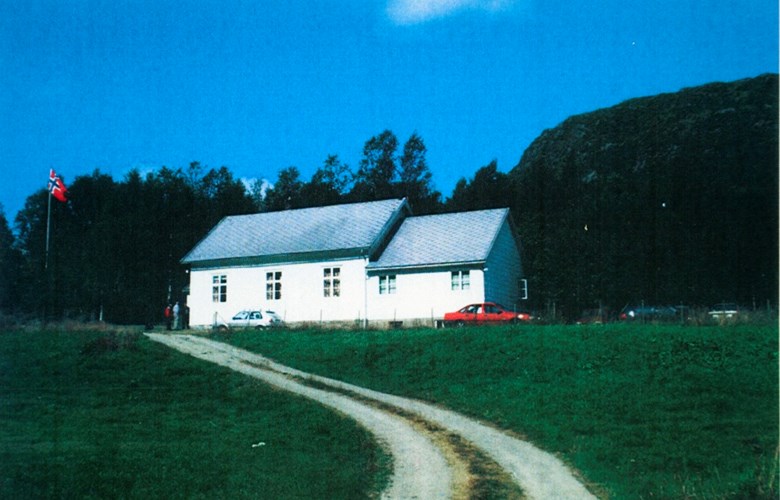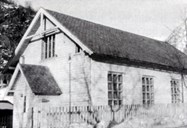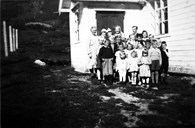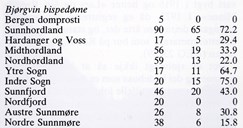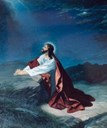The construction work
On 13 May 1914, a meeting was held at the schoolhouse of Dalsøyra with a view to building a "bedehus" in the village. The meeting decided to start the construction work and statutes were passed. John Kjellevold, Martinus Haveland and Ola Lihaug, who had taken the initiative for the meeting, were chosen to sit on the board of the house.
Some men went to Vadheim to take a look at the "bedehus" there. They wanted a similar house at Dalsøyra. John Kjellevold gave the lot for free on the south side of the hill called Biskophaugen, close to the old rural road. The lot had a central location in relation to the outlying areas in the village.
The construction work was then started. The house was built without a basement. Only a small and low room in the eastern corner was made for storing firewood. Ole Lihaug, Martinus Haveland and several others were experienced builders so no professional help was needed. All the construction work was done on a voluntary basis. Elling Lihaug made the rostrum and Bertel Berge made the windows.
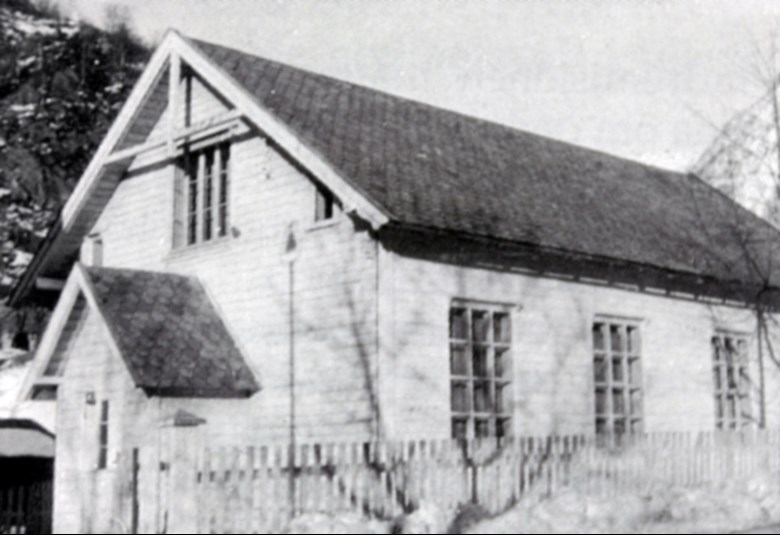
Furnishings
The house measured 12 by 8.6 metres with a small annexe serving as an entrance and porch. There were two halls in the house, one bigger than the other, and a kitchen. Above the smallest hall and kitchen there was a gallery with a seating capacity of 50. Four-five steps led up to the rostrum. The main hall had a half-vaulted ceiling with a full opening to the gallery. Walls and ceiling were panelled.
Big lamps provided sufficient light. The main hall had a big, round stove for heating, and the small hall had a tall stove. The kitchen had a stove with a stovepipe out to the chimney in the small hall. The staircase to the gallery went through the kitchen but was later moved to the back wall of the small hall. In the eastern gable wall in the main hall two brace supports were added as the wall creaked in windy conditions.
Consecration
The house was consecrated on 1 June 1916 by the secretary in "Det Vestlandske Indremisjonsforbund", Andreas Lavik. This was indeed a festive occasion and many people took part. Some had even come from faraway places. Sour-cream porridge and sandwiches were served, and there were speeches and presents. Dorthea and Lasse Lund gave a Bible and a New Testament.
Renovation
As years passed by, it became necessary to renovate the house. In 1949, it was agreed to raise money for a major renovation work, and the following year, a building committee was appointed. A new floor was laid on top of the old one. The ceiling vault in the main hall was lowered about 1.3 metres. The walls and the ceilings in both halls were clad with porous "Huntonitt" wallboards, and birch plyboards were put on the walls up to 1.5 metres from the floor. At the front towards the galleries hatches were made, and between the halls a loose partition wall was installed.
In 1958, the old roof tiles were replaced by asbestos cement tiles. On the sidewall up towards the road new windows were made in 1961, and the stove in the small hall replaced in 1974. Electricity was installed in 1945, and inlaid water came in 1971.
Annexe
Gradually people realized that it was necessary to build an annexe with a dining hall, kitchen and a new porch with wardrobe and toilet facilities. The groundwork was carried out in the winter of 1964. Henrik Rotheim dug out the site and Søren Virkesdal took care of the drilling and blasting. In late autumn 1965 an 86.7-square-metre roof was laid on the annexe, of which 53.9 sq.m. above the dining hall and 26.9 sq.m. above the kitchen. Olav Molde and Elling Lund were in charge of this work, helped by others. The kitchen was roomy and the dining hall could seat 70-80 persons.
In 1971, a new entrance/porch was built with wardrobe and toilet facilities, measuring 15.8 square metres. The old kirchen now became part of the wardrobe.
Decoration
On 17 May 1917, a framed portrait of Christ was hung up on the front wall of the main hall. The Bible verse from John 17:4 "Father, I will that they also¿" is written on the portrait which was a gift from Marianne E. Erstad née Ellingsen in memory of her father, Ivar Ellingsen Berge. In 1952, this portrait was moved to the small hall. The same year the big painting (1.65 x 1.95 metres) portraying Jesus in the Garden of Gethsemane, painted by Vilhelm Bjørknes, was placed on the front wall in the main hall. Bjørknes charged only 300 kroner for this big painting, paid by six persons. Konrad Lihaug made the frame.
The main hall is also decorated with two pictures by Marie Halland, one with the words "Rejoice in the Lord", the other with the words "By grace you are saved". Eldbjørg Molde has given an embroidered wall tapestry with the inscription "Have faith in the Lord". A similar tapestry was given by Margit Kjellevold with the inscription "Jesus is alive".
In the dining room there is another Christ portrait also painted by Vilhelm Bjørknes. It was given by Margit and Ole Kjellevold. In the dining hall there is another tapestry given by Klara and Elling Kjelby depicting the Holy Communion.
Statutes
Statutes for the Dalsøyra "bedehus" were passed in the schoolhouse meeting on 13 May 1914. Sections 1-3 determine what the house can be used for.
§ 1) Dalsøyra "bedehus" is owned by "Dalsøyra Indremisjonsforening", and the activities in the house must be in accordance with God's words and the Evangelical-Lutheran creed.
§ 2) "Dalsøyra Indremisjonsforening" has at any given time priority to using the house. When it does not constitute a hindrance to the association's work, the house can be used for any activity in God's kingdom pursuant to § 1.
§ 3) When it is not a hindrance to the use of the house according to § 2, the house can be used for meetings for good and beneficial purposes and activities. However, there must be constant control to check that these meetings are not contrary to God's words and true Christian morality.
Activities in the first few decades
In 1959, Hans I. Dale wrote an article on the activities in the Dalsøyra "bedehus" in the church magazine Kyrkjelydsblad for Gulen og Mjømna. "Many of us had longed strongly for a general revival in the village, and it came in the winter of 1914-1915 with the emissary Klingsheim from the Stavanger area. He was God's instrument, full of the Holy Spirit, and a firm believer. Throughout the winter meetings were held practically every day, and young and old people came to these meetings and testified of a complete and free salvation."
Besides ordinary meetings, there were also annual Christmas meetings. Many people turned up for these meetings, also many youths and children. When the Sunday school was established in 1932, it also organized Christmas meetings for its members. Many meetings were organized to raise money for various purposes. There were also bigger gatherings where people from near and far attended. Occasionally a group of women came together for prayer meetings. They usually stayed in the kitchen beside the small hall, because this was the easiest room to heat in the winter months.
Revival in 1945
Many prayed for a revival in the village. It came in March 1945. Two men, Anders Husebø and Peder Veiberg, who worked for the "Misjonssambandet", came to hold meetings at the "bedehus". Meetings were held every evening for three weeks and many people attended. At these meetings many accepted Jesus as their saviour and Lord. The speakers also sang together, and P. Veiberg sometimes played the accordion. Usually these meetings were long, with prayers, conversations and spiritual guidance. On the way home after the meetings young people sang. Wherever people met, the activities at the "bedehus" were a frequent topic of conversation.
At these meetings a song group was established led by Odny Haveland. This group took part at meetings for some time. On 31 March, a Christian youth club was established with Borghild Nerdal as leader, later on led by Sjur Dale. The club magazine Samhald was read for the first time on 22 April 1945. The last issue is dated 11 July 1948.
The lay movement experienced some good years after the revival in 1945 with good attendance at meetings and gatherings. The upgrading of the "bedehus" building was also an inspiration for its members. Most young people left the village to go to school or find work. When many elderly people also dropped out, this meant that the meetings became less frequent and with reduced attendance. The song group also broke up.
The Sunday school
The Sunday school was probably started in 1932 and was continuously active until 1993-1994. The Sunday school met at the "bedehus", and during the first few years it was led by Brita Kjellevold, Elevine Nordal and Berentine Lihaug among others. From 1947 Marie Halland and Olav Molde were leaders together until 1970-75. Then Olav Molde was leader alone until 1990, and Hildegunn Atterås Aspen for some more years.

During the first few years the Sunday school met every Sunday, later on every other Sunday. The school was fairly well attended. Every summer there was an excursion, sometimes together with other Sunday schools. There were annual Christmas meetings.
The Gulen gathering
In the 1950s, the Gulen gathering was established, organized by the Christian youth clubs at Byrknesøy, Eidsbotn and Dalsøyra. The gathering took place every year and the venue was on a rotation basis at these three places. Speakers usually came from "Misjonssambandet". Vilhelm Bjørknes was frequently used as a speaker. In the past few years, speakers have come from "Sogn Indremisjon" and the offering has also gone to this organization. For many years now the gathering has taken place every other year at Byrknes and Dalsøyra. "Brekke Musikklag" has often contributed with song and music.

